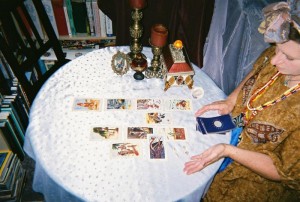Some History about the Tarot Cards
Origins and History
The Tarot has been used as a method of forecasting events to come or to reveal secrets that have not been revealed for centuries. The deck of cards we know as the Tarot have been associated with a nation of people loosely called “Gypsies”; people who came from Egypt and Chaldea into Israel and Greece. The people known as Gypsies traveled throughout the continents of Europe and Asia, settling in the area we now know as Romania/Austria/Hungary. Interestingly enough, the Hungarian Gypsy word for a deck of cards is “tar”.
 Legends tell that as religious persecution fell on pagan cults, the Hierophants or the Priests of the Mysteries, handed down their knowledge to the humble Gypsies. These travelers in turn taught those they deemed worthy of such treasure.
Legends tell that as religious persecution fell on pagan cults, the Hierophants or the Priests of the Mysteries, handed down their knowledge to the humble Gypsies. These travelers in turn taught those they deemed worthy of such treasure.
Many other fascinating lore surround the Tarot but the first real evidence that we have of the Tarot are decks of cards located in European museums that date to about 1390. In the Museo Correr in Italy, there are some cards dating around 1445 but the main surge of information about the Tarot shows up during the reign of Charles VI of France during the fourteenth century. In England, the Tarot was popular during the fifteenth century reign of Edward IV. It was in the eighteenth century that French scholar Court de Gebelin suggested that the Tarot may be of Egyptian origin and his discovery came at a time when the study of Rosicrucianism was popular pastime.
The Tarot took many side trips and acquired much more history and took on many changes and many different looks to the decks. As the Tarot has gone through many transformations over the centuries, it endured and serves as a reminder that Truth and the pursuit of it endures time.
Click here to contact me.









